Physical Address
304 North Cardinal St.
Dorchester Center, MA 02124
The overwhelming majority of sellar region masses are pituitary adenomas (85%), followed by craniopharyngioma (3%), Rathke cleft cyst (2%), meningioma (1%), and metastases (0.5%); other lesions such as hypophysitis, pituicytoma, spindle cell oncocytoma, and granular cell tumor of neurohypophysis are rare. However, when these other sellar masses do occur, most so closely mimic pituitary adenoma on neuroimaging studies that the clinical/neuroimaging diagnosis is incorrect and thus, diagnosis falls to the surgical pathologist, necessitating discussion of their histologic features.
Today, immunohistochemistry (IHC) has largely supplanted electron microscopy (EM) for much of general surgical pathology, and while there is still a possible role for the latter in diagnosing very rare subtypes of pituitary adenomas, the chapter will be directed towards practicing surgical pathologists who generally do not have ready access to EM. Previous editions of this book, as well as the World Health Organization (WHO) fascicle, can be consulted for gross and EM images. Antibodies specific for anterior pituitary hormone immunohistochemical antibodies, as well as for those directed against transcription factors (pituitary transcription factor-1 [PIT1] for prolactin [PRL]-, growth hormone [GH]-, and/or thyroid-stimulating hormone [TSH]-immunoreactive tumors, steroidogenic factor-1 [SF1] for gonadotroph adenomas, TPIT for corticotroph adenomas), are becoming more widely utilized. However, not all are readily available, and several recently proposed alternate ways to use these antibodies in smaller panels for pituitary adenoma classification will be discussed.
The anterior lobe (pars distalis) is derived from Rathke pouch, a tube of tissue which invaginates from the fetal oral (stomodeal) ectoderm anterior to the roof of the primitive mouth, forms by the fourth to fifth week of human gestation, migrates dorsally towards the base of the brain, and comes in contact with the diencephalon. At the sixth fetal week, a down-pouching of the floor of the third ventricle and diencephalon forms and Rathke pouch detaches from the oral epithelium and becomes a separate structure. Cellular proliferation begins, with the ventral part of Rathke pouch giving rise to the pars distalis and the dorsal part to the pars intermedia. The diencephalic diverticulum thereafter narrows and is obliterated.
The infundibular stalk and posterior gland arise from the infundibular anlage in the floor of the third ventricle. Early in gestation, cells in the infundibular anlage and ependymal and subependymal cells of the fetal third ventricle manifest nuclear immunostaining for TTF1. As early as 12 weeks' gestation, the posterior gland (neurohypophysis) shows nuclear TTF1 immunoreactive pituicytes ( Fig. 44.1 ), and this is retained in adults ( Fig. 44.2 ). In contrast, the immature cerebral cortex and lateral ventricles show no TTF1 immunoreactivity; anterior pituitary (adenohypophysis) cells are entirely negative, both embryologically and in adulthood. Today it is recognized that 3 rare neurohypophyseal neoplasms, i.e., pituicytoma, spindle cell oncocytoma, and granular cell tumor, are derived from pituicytes and share this TTF1–positive lineage. TTF1 IHC thus serves as an excellent diagnostic tool in differentiating these 3 tumors from TTF1 immunonegative pituitary adenomas, meningiomas, schwannomas, and other spindle cells masses.
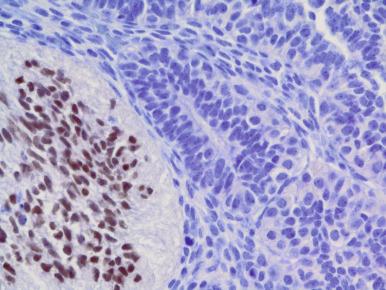
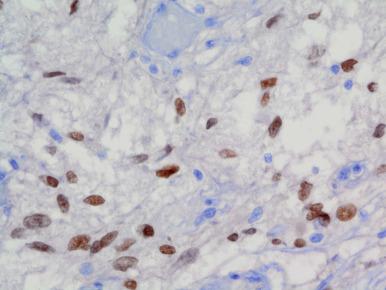
By the 14th week of human gestation, pituitary development is essentially complete. The two parts of the pituitary gland are easily distinguished during fetal development ( Fig. 44.3 ) and the anterior gland shows immunoreactivity for specific anterior pituitary hormones ( Fig. 44.4 ). After birth, the gland grows rapidly, reaching a plateau at about 3 years of age; rapid growth again occurs between ages 10 and 13 years. Modern neuroimaging allows distinction between adult anterior (adenohypophysis) and posterior (neurohypophysis) lobes ( Fig. 44.5 ).
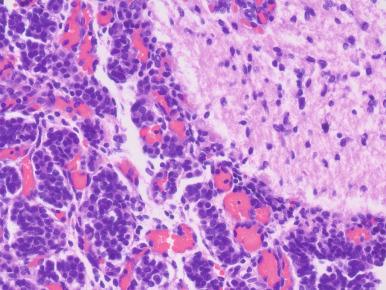
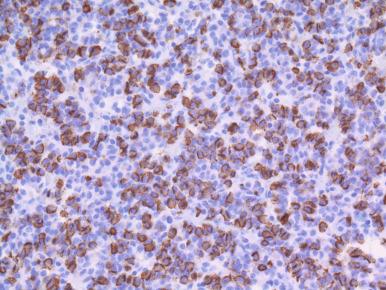
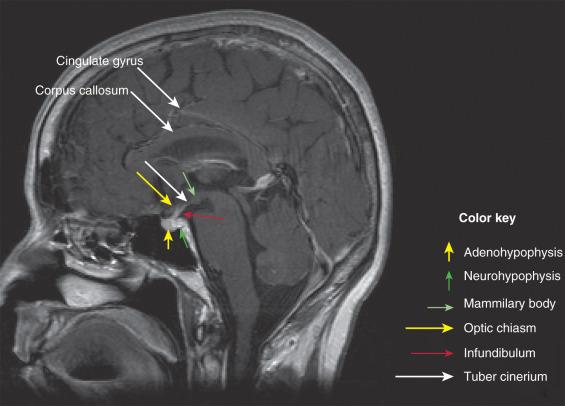
Six distinct hormone-secreting cell types appear during anterior pituitary gland development: the corticotroph (adrenocorticotropic hormone–secreting, ACTH), somatotroph (GH-secreting), lactotroph (PRL-secreting), mammosomatotroph parent cell for GH and PRL, gonadotroph (follicle-stimulating hormone- and luteinizing hormone-secreting, FSH and LH, in a single cell), and thyrotroph (TSH). A number of different pituitary-specific transcription factors also play a role in the determination of pituitary cell lineages. Of these, however, only PIT1 (associated with PRL-immunoreactive, GH-immunoreactive, and TSH-immunoreactive adenoma subtypes, Fig. 44.6 ) and SF1 (associated with gonadotroph lineage tumors, Fig. 44.7 ) are typically widely available for diagnostic use. Other hormones and transcription factors, such as TPIT, ER, and GATA2, are often only available at laboratories specializing in pituitary adenomas.
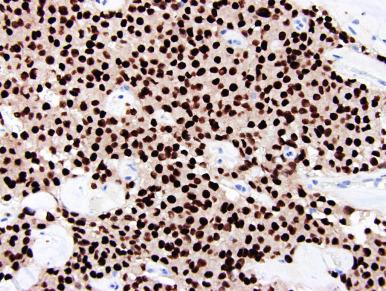
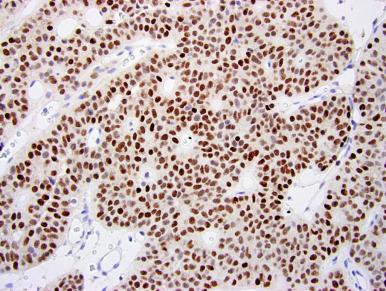
Most pituitary adenomas show hormone expression profiles that recapitulate these expected developmental lineage pathways. Corticotrophs and gonadotrophs usually show only lineage-specific, relatively restricted hormonal expression driven by TPIT and SF1, respectively. For example, corticotroph cell adenomas usually show immunoreactivity for ACTH but none of the other hormone types. Thus, given the general unavailability of TPIT IHC in general practice, this family lineage is usually identified by ACTH immunoreactivity. However, a recent study showed that a minority (32/119) of hormone-negative adenomas with only a few (<1%) entrapped ACTH-positive cells were found to be Tpit immunoreactive, identifying them as clinically silent corticotroph adenomas. Clinically, patients with these tumors had demographic and neuroimaging features similar to clinically silent corticotroph adenomas that have larger numbers of ACTH-positive cells. Thus, future categorization of corticotroph adenomas may require the use of more specific transcription factor immunostaining.
Gonadotroph adenomas manifest immunoreactivity only for FSH-β and/or LH-β, with or without alpha subunit (αSU) (all secreted by the same cell in the normal anterior pituitary gland), but not other hormone types. Estrogen receptor (ER) is also positive in gonadotrophs, but this antibody cannot substitute for FSH and LH in classifying gonadotroph adenomas, due to limited utility because of tissue fixation issues, as well as the fact that PRL-producing adenomas are also ER positive. Currently, by definition, a gonadotroph adenoma must express FSH-β and/or LH-β, or, in the absence of availability of these antibodies, nuclear SF1, in order to distinguish it from other types of hormone-negative adenomas, although the majority of hormone-negative adenomas (i.e., negative for GH, PRL, ACTH, FSH, LH, TSH) are also, in fact, SF1-driven gonadotroph adenomas.
In contrast, GH, PRL, and sometimes αSU and TSH are often coexpressed in PIT1-lineage tumors, due to their common transcription factor and precursor during fetal development—the “parent” mammosomatotroph cell. There is fluidity between four of the cell types (GH, PRL, mammosomatotroph, and TSH cells), which are able to reversibly transdifferentiate under physiologic or disease conditions ; this perhaps further explains the wide variation in expression of these hormone types in PIT1-driven adenomas. Table 44.1 and WHO 2017 Classification lists the lineages of pituitary adenomas, as driven by PIT1, SF1, and Tpit.
| Pituitary transcription factor (PIT1) |
|
|
|
|
|
|
|
| Steroidogenic factor (SF1) | Gonadotroph adenoma, with or without IHC(+) for FSH, LH * |
| TPIT |
|
| Transcription factor negative/unknown | Null cell adenoma † |
| Unusual plurihormonal types with hormonal combinations not readily explained by cytodifferentiation | Uncertain lineage |
* Presence of SF1 defines gonadotroph adenoma even if hormone negative)
† Should be defined as SF1, PIT1, ACTH/TPIT IHC negative (TPIT IHC not as widely available); category severely reduced by use of transcription factor IHCs.
The normal anterior gland is arranged in relatively evenly sized clusters of cells, known as acini, which contain an assortment of cell types ( Fig. 44.8 ) and are outlined by reticulin fibers ( Fig. 44.9 ). Hormone cell types in the anterior gland are not equally distributed, with larger numbers of PRL- and GH-positive cells in the lateral portions (lateral wings) and larger numbers of ACTH-positive cells, and to a lesser extent TSH-positive cells, in the median mucoid wedge. IHC (+) cells are more diffusely distributed.
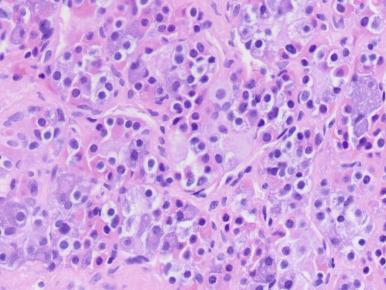
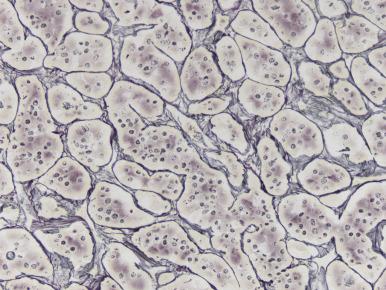
Anterior pituitary cells are immunoreactive for synaptophysin, and variably with chromogranin A and CAM5.2. Virtually all pituitary adenomas are diffusely synaptophysin positive ( Fig. 44.10 ) but show variable immunoreactivity with the other two antibodies. Box 44.1 lists the histochemical and IHC profiles of anterior and posterior pituitary gland cells as well as for adenomas in general.
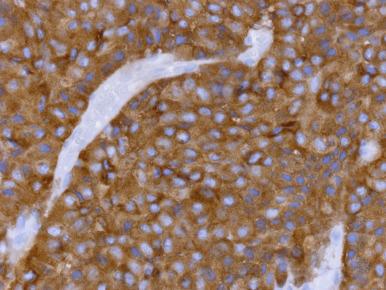
Reticulin : disruption of acinar pattern in all adenomas, expansion in rare hyperplasia
Periodic acid–Schiff (PAS) : strongly positive in densely granulated ACTH adenomas
Cytokeratin 7 : negative or only rare positive cells in almost all adenomas
Cytokeratin 20 : positive in most densely granulated ACTH adenomas, negative in sparsely granulated GH adenomas; positive in all sparsely granulated but not in any densely granulated GH adenomas; positive in nontumorous Crooke cells in patients with hypercortisolism of any etiology
CAM5.2 (keratin 8/18): extensive and diffuse in all densely granulated ACTH adenomas, most densely granulated GH adenomas in perinuclear pattern, all sparsely granulated GH adenomas in a fibrous body pattern, most mixed GH-PRL adenomas, half of all prolactinomas, gonadotroph adenomas, and null cell adenomas
Synaptophysin : positive in normal anterior and posterior gland and all adenomas
Neurofilament : positive in axons in normal posterior pituitary gland
Glial fibrillary acidic protein, S-100 : focally present in posterior gland; identifies nonhormone–containing folliculostellate cells in anterior pituitary gland
Chromogranin A : characteristic of gonadotroph adenomas; lacking in both PRL and ACTH functioning adenomas; poorly expressed in GH and GH-PRL functioning adenomas
Estrogen receptor : all prolactin IHC+ adenomas (sparsely, densely granulated lactotroph adenomas, acidophil stem cell, mixed GH-PRL, mammosomatotroph adenomas); gonadotroph adenomas (due to fixation issues can be focal and weakly positive)
In contrast to the complex anterior pituitary gland, the posterior lobe is more histologically monotonous and composed of unmyelinated axons and specialized glia. The gland has a glial, fibrillary appearance with prominent delicate blood vessels. Small fragments of normal posterior gland are often found in surgical resection specimens of Rathke cleft cysts and occasionally in resection specimens for pituitary adenomas. Swellings of axons that store oxytocin or vasopressin can occasionally be discerned on H&E (Herring bodies) and are normal findings. Anti-neurofilament is the single best stain for confirming the identity of the axon-rich posterior gland ( Fig. 44.11 ) and distinguishes it from other lesions (such as pituicytoma, pilocytic astrocytoma, and meningioma) that might mimic normal posterior gland. Although it may be alarming to the surgical pathologist when these fragments of posterior gland are found within a surgical specimen, it is important to remember that the posterior gland is a storage site, not a synthesis site, for these hormones. Preoperative presentation of pituitary adenomas with diabetes insipidus is distinctly uncommon, and postoperative posterior pituitary gland dysfunction after modern trans-sphenoidal resection is usually limited to transient diabetes insipidus that resolves after several days. Removal of these small fragments of posterior gland appears to have no long-lasting deleterious clinical effects in most patients.
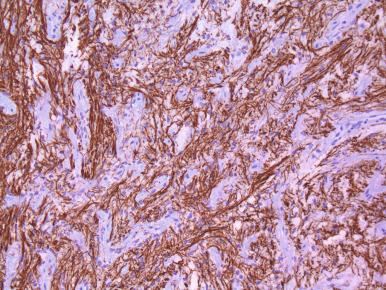
The infundibular stalk is part of the posterior lobe and contains closely juxtaposed, thin-walled blood vessels that transport hypothalamic release and release-inhibiting factors to the anterior gland. When the infundibular stalk is compressed by a mass lesion, or undergoes any traumatic or circulatory disruption, the delicate, thin-walled vessels of the hypothalamic–hypophyseal portal system are pinched off and hypothalamic release and release-inhibiting factors do not reach the pituitary gland. Under normal physiologic conditions, the one anterior pituitary hormone that is more tonically inhibited than stimulated is PRL; the hypothalamic inhibiting factor is dopamine. Interruption of the infundibular stalk by any mass lesion will abrogate passage of inhibitory dopamine to the anterior gland and result in hyperprolactinemia of a modest degree (30–200 ng/dL [or 250 ng/dL]).
Adenomas constitute 10%–15% of all intracranial neoplasms in most neurosurgery practices. The vast majority of adenomas are sporadic, and mutations in known oncogenes have little role in the pathogenesis of most sporadic pituitary adenomas. The only somatic mutation that has been identified in a significant proportion of sporadic pituitary tumors is the GSP mutation, which causes constitutive activation of the cAMP pathway. This mutation occurs in approximately 30%–40% of sporadic GH-secreting pituitary adenomas but not other adenoma types. Abnormalities in signaling and feedback pathways have been demonstrated in pituitary tumors, but they are unlikely to be the primary events responsible for sporadic tumors. Pituitary adenomas are clonal, but no specific chromosomal alterations are characteristic. Increasing chromosomal imbalances have, however, been demonstrated in recurrent tumors.
Familial adenomas account for 5% or less of all adenomas, with germline mutations in the MEN1 gene associated with multiple endocrine neoplasia (MEN) type 1 identified in 2.7% of individuals with apparently sporadic pituitary adenomas. Pituitary adenoma predisposition syndromes include MEN 1 (gene MEN1 , chromosome 11q13, results in all pituitary tumor types), Carney complex (gene PPKR1A , chromosome 17q22–24, associated with GH- or PRL-secreting adenomas), MEN 4 (gene CDKN1B , chromosome 12p13), and familial isolated pituitary adenomas (FIPA, gene AIP , chromosome 11q13.32).
The practical issue for both pathologist and clinician is when to suspect/advise work-up for genetic mutations in a patient with a pituitary adenoma. While those with known multiple endocrine tumors and/or family history are obvious, it is becoming apparent that young patients with seemingly sporadic pituitary macroadenomas may be candidates for assessment. In one study of 174 macroadenoma patients of at least age 30 years, and without hypercalcemia or MEN 1-associated lesions, 12% had mutations of AIP or MEN1 (8.6% and 3.4%, respectively). However, when pediatric patients (≤18 years old) were assessed, 22% (10/46 patients) had such mutations.
No strong relationship to birth control pill use has been established. Endocrine end-organ failure is not related to pituitary adenoma development either, except in the rare instance of TSH hyperplasia in patients with longstanding hypothyroidism evolving into adenoma. Antecedent or concomitant hyperplasia with adenoma is exceedingly rare. Although hormone receptor mutations in pituitary cells is an attractive hypothesis for adenoma causation, at least in gonadotroph adenomas no activating mutations in the gonadotropin-releasing hormone (GNRH) receptor gene have been identified.
Pituitary adenomas usually develop in the third to sixth decades, but pediatric examples certainly occur. Infantile pituitary blastomas, which are rare lesions associated with DICER1 mutations, are hormonally active and at least focally immunoreactive for ACTH ( Fig. 44.12 ); however, these represent an entity distinct from pediatric pituitary adenomas. Pituitary adenomas are not related to DICER1 mutations.
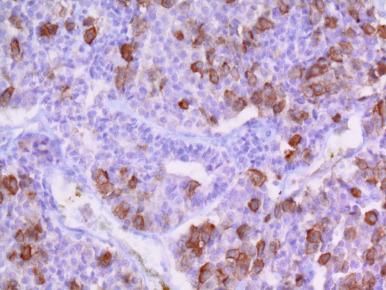
Conversely, pituitary adenomas coming to neurosurgical resection at the other extreme of the age spectrum are not rare. In a retrospective study from 1992 to 2002, detailing patients aged 75 years or older who had symptomatic lesions requiring neurosurgical intervention, pituitary adenomas were the third most frequent tumor type.
The relative frequency of the various pituitary adenoma types differs, depending on whether one is looking at autopsy or surgical material ( Table 44.2 ). Ezzat et al. found that 22.5% of persons harbor pituitary lesions on neuroimaging studies, and 14.5% of autopsy pituitary glands contain microadenomas. The most frequently occurring adenoma found as an incidental finding at autopsy is the PRL-secreting adenoma ( Fig. 44.13 ).
| ADENOMA TYPE | ADENOMAS COMING TO SURGERY (%) ( n = 3403) a | SUBCLINICAL ADENOMAS POSTMORTEM (%) ( n = 334) b |
|---|---|---|
| Densely granulated GH cell adenoma | 9.2 | 0.90 |
| Sparsely granulated GH cell adenoma | 6.3 | 1.20 |
| Sparsely granulated prolactin cell adenoma | 8.9 | 39.5 |
| Densely granulated prolactin cell adenoma | 0.3 | — |
| Mixed bicellular GH/prolactin cell adenoma | 5.2 | 0.30 |
| Mammosomatotroph adenoma | 1.1 | — |
| Acidophil stem cell adenoma | 0.2 | — |
| Densely granulated ACTH cell adenoma | 7.2 | 8.08 |
| Sparsely granulated ACTH cell adenoma | 7.9 | 5.69 |
| Crooke cell adenoma | 0.03 | 0.30 |
| TSH cell adenoma | 1.5 | 0.60 |
| FSH/LH (gonadotroph) cell adenoma | 25.2 | 6.6 |
| Null cell adenoma | 19.8 | 23.1 |
| Null cell adenoma, oncocytic variant | 5.8 | 9.3 |
| Plurihormonal adenoma, including plurihormonal PIT1-positive adenoma | 1.3 | 2.7 |
| Unclassified | 2.1 | 1.8 |
a Data from Saeger W, Ludecke DK, Buchfelder M, et al. Pathohistological classification of pituitary tumors: 10 years of experience with the German Pituitary Tumor Registry. Eur J Endocr. 2007;156(2):203–216.
b Buurman H, Saeger W. Subclinical adenomas in postmortem pituitaries: classification and correlations to clinical data. Eur J Endocr. 2006;154(5):753–758.
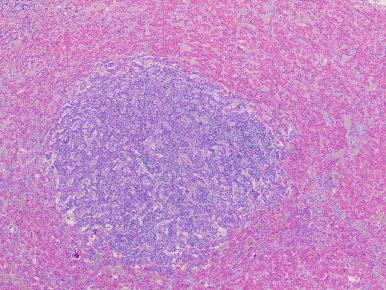
As PRL-secreting adenomas are now routinely treated chemically with dopamine agonists such as bromocriptine, Parlodel, or cabergoline, patients no longer come to surgery unless they are drug intolerant or have other mitigating circumstances. In one of the largest series of 3489 pituitary tumors from nine centers in Germany, FSH/LH cell adenomas predominated in surgical material (see Table 44.2 ); this study, as in most, however, antedates use of SF1 IHC and numbers may actually be even larger. ACTH-producing adenomas were fourth in incidence, and TSH-secreting tumors were very rare. Many clinically nonfunctional/clinically silent adenomas classified in the past as “null cell” are now recognized, with improved IHC, to either show focal individual cells that are immunoreactive for gonadotrophic (FSH, LH) hormones and/or express SF1 (see Fig. 44.7 ) and thus occur within the same biologic spectrum and lineage pathway as gonadotroph adenomas. Indeed, the majority of both clinically silent/nonfunctioning and hormone-negative adenomas express SF1. As noted above, the use of SF1 IHC divides gonadotroph adenomas from other types of hormone-negative adenomas, and the use of TPIT IHC may further reduce numbers of true null cell adenomas, although reliable commercially available antibodies have been lacking to date. Two or more adenomas arising within the anterior pituitary gland of a single patient have also been reported, but these multiple lesions within the same gland of a patient are more commonly recognized at the time of autopsy when the entire pituitary gland is available for histologic review. Double adenomas within a single patient's pituitary gland are less commonly recognized in surgically resected material.
Particularly complex are those clinically functioning adenomas that result in acromegaly and hyperprolactinemia, as detailed in Table 44.3 . Except for dual GH and PRL elevations, generally, only one, or rarely two, hormones are produced in sufficient quantities to result in elevated serum levels and produce clinically discernible endocrinopathies. If the tumor is inefficient at producing hormones, the mass effects and hypopituitarism predominate because of compression of the optic chiasm and normal gland.
| Pituitary Adenomas Causing Acromegaly/Gigantism, With GH, CAM5.2 Pattern IHC Pattern | |
| Densely granulated somatotroph (growth hormone) adenoma— diffuse, strong GH IHC(+) | CAM5.2 perinuclear |
| Intermediate/mixed/transitional growth hormone adenoma (behaves like densely granulated growth hormone adenoma— diffuse, strong GH IHC(+) | CAM5.2 mostly perinuclear, fibrous bodies less than 70% |
| Sparsely granulated growth hormone adenoma— weak, focal GH IHC(+) | CAM5.2 fibrous bodies greater than 70% |
| Mixed growth hormone-prolactinoma— GH IHC(+) in varying degrees and distribution (small groups to scattered admixed cells); Prolactin IHC(+) stronger than in densely or sparsely granulated GH adenoma | CAM5.2 pattern depends on whether GH component densely or sparsely granulated. that is, subset of cells perinuclear versus dot-like fibrous body |
| Mammosomatotroph adenoma— diffuse, strong GH IHC(+), often with alpha subunit, PRL, sometimes FSH, LH | CAM5.2 mostly perinuclear, fibrous bodies rare if present at all |
| Plurihormonal PIT1 positive adenoma —rare aggressive subtype composed of monomorphic cells diagnosable by electron microscopy only; some being recognized as producing mild acromegaly, less commonly hyperthyroidism or mild hyperprolactinemia | CAM5.2 perinuclear in most, occasional fibrous bodies or negative CAM5.2 |
| Pituitary Adenomas Causing Hyperprolactinemia, With PRL, CAM5.2 Pattern IHC Pattern | |
| Sparsely granulated prolactin secreting (lactotroph) adenoma— diffuse strong PRL, Golgi pattern | CAM5.2 often moderate, no fibrous bodies |
| Densely granulated prolactin secreting (lactotroph) adenoma— diffuse, strong PRL, may be perinuclear rather than Golgi | CAM5.2 no fibrous bodies |
| Acidophil stem cell adenoma— diffuse cytoplasmic PRL IHC(+) except in rare instances where Golgi pattern present; focal GH in approximately |
CAM5.2 approximately 2/3 with fibrous bodies, usually scattered rather than prominent; sometimes CAM5.2 IHC negative or perinuclear pattern |
Subtyping of pituitary adenomas by hormonal type and subtype is still necessary, as pituitary adenomas are not a homogeneous entity and each subtype has its own clinical presentation, tendency for invasiveness, hormonal secretion pattern, histopathologic features, appropriate treatment, and varying response to medical therapies. Some adenomas are well-differentiated tumors that closely mimic their non-neoplastic anterior pituitary counterparts, such as densely granulated GH adenomas or the common sparsely granulated PRL adenomas (which resemble stimulated nontumorous lactotrophs by EM), while others (such as sparsely granulated GH adenomas, acidophil stem cell adenomas, and the rare silent subtype 3, which is still impossible to diagnose confidently without EM) are less differentiated.
Not surprisingly, those adenomas showing advanced differentiation by EM more closely mimicking that of normal nontumorous anterior pituitary cells show greater response to medical therapies (i.e., prolactinomas with dopamine agonists, or densely granulated GH adenomas with somatostatin analogues) than do poorly differentiated tumors (rare densely granulated lactotroph adenomas, acidophil stem cell adenoma, or sparsely granulated GH adenomas). Thus, subtyping predicts which adenomas are likely to be clinically responsive to medical therapy and may direct the use of alternate therapies, based on subtype. An example of the latter is that sparsely granulated GH adenomas that are not controlled with somatostatin analogs consistently respond to the alternate use of, or addition of, a GH receptor antagonist. Subtyping does not usually dictate the use of adjuvant radiation therapy. Instead, recurrent, invasive aggressive adenomas that cannot be completely surgically resected may be candidates for radiation therapy or radiosurgery. However, adjuvant radiation is generally not administered after the first resection, or simply because of subtotal resection. For instance, incompletely resected indolent adenomas, such as gonadotroph adenomas, can usually be managed conservatively without adjuvant radiation.
Some adenomas are strongly secretory and produce the hypersecretory syndromes of hyperprolactinemia, acromegaly/gigantism, or Cushing disease (lactotroph, somatotroph, and corticotroph adenomas, respectively [see Table 44.3 ]), while others are mostly clinically silent/nonfunctional, such as gonadotroph adenomas and null cell adenomas. Other rare types of silent adenomas (silent corticotroph, somatotroph, lactotroph, and thyrotroph adenomas) and variably clinically functional adenomas (acidophil stem cell and plurihormonal adenomas made up of multiple cell types) also exist. In some endocrinologically functional adenomas, serum level of hormone strongly parallels the size of the adenoma, as in sparsely granulated PRL adenomas (typical prolactinoma). In others, such as corticotroph adenomas associated with Cushing disease, tumor size does not correlate with severity of clinical features or serum hormone levels. Indeed, florid Cushing disease can be produced by ACTH-secreting adenomas that are only millimeters in size. As is always the case, IHC is a test that is “static” in time, that is, it measures content within the cytoplasm at a singular time point but does not provide information regarding secretory rates of a hormone product, if any. Gonadotroph adenomas, for example, usually show immunoreactivity for FSH and/or LH but almost never produce a clinical hypersecretory condition; these tumors are in fact the most common subtype of clinically nonfunctioning/silent adenomas even if immunoreactive for FSH and/or LH Hormone-negative pituitary adenomas, defined as negative for specific anterior pituitary hormones by IHC, are today recognized to be most commonly of gonadotroph lineage as well, as identified by positive immunostaining for the transcription factor SF1.
At times, discordance between immunoreactivity and clinical features is actually helpful in subtyping. An example of the latter is acidophil stem cell adenomas, which show variable immunopositivity for prolactin and variable elevation in serum levels of prolactin, and almost always show a discordance between tumor size (often large) and serum prolactin levels (typically only modestly elevated) when compared to similarly sized sparsely granulated PRL adenomas (i.e., typical prolactinomas). Correlations between subtypes of adenomas and neuroimaging features also exist.
While all hormone-negative adenomas (i.e., negative for the standard anterior pituitary hormones GH, PRL, ACTH, FSH, TSH, +/− LH) are clinically silent/clinically nonfunctional, the reverse is not true. Namely, adenomas may secrete such small amounts of hormone, as in gonadotroph adenomas with focal immunoreactivity for FSH and/or LH, that they are clinically silent. Alternatively, in some instances such as clinically silent ACTH adenomas, the adenoma may show immunoreactivity for ACTH, but the hormone product may be biologically nonfunctional. The most common type of clinically silent adenoma is the gonadotroph adenoma, followed by clinically silent ACTH adenomas. Clinically silent GH, PRL, and TSH adenomas are rare. Hormone-negative adenomas can be further subclassified as to lineage origin by IHC for transcription factors SF1, PTI1, and TPIT. Most hormone-negative adenomas are SF1 driven and are thus classified as gonadotroph adenomas. The second most frequent hormone-negative adenoma type is TPIT driven and thus they are classified as corticotroph adenomas ; PIT1-driven hormone-negative adenomas are very rare.
World Health Organization grade is not assigned to pituitary adenomas, since numerical grades have historically been utilized by neuroimaging colleagues for assessing CT and resonance MRI extent of disease.
The Hardy system from 1973, utilizing grade as assessed from CT and MRI studies, is as follows:
Grade I: Microadenomas, defined as intrapituitary lesions measuring less than 1 cm in diameter
Grade II: Macroadenomas, defined as at least 1 cm in diameter
Grade III: Locally invasive tumors (small or large) that cause bony erosion of sella turcica
Grade IV: Macroadenomas with invasion of extrasellar structures such as bone, hypothalamus, cavernous sinus.
The Protocol for Primary Pituitary Tumors does not require listing of the specific Hardy system grade but does include in the checklist the “Tumor Size (from imaging)” as microadenoma (<1 cm) or macroadenoma (≥1 cm).
Microadenomas remain confined to the sellar region and may cause some degree of hypofunction of the normal anterior pituitary gland due to compression but seldom result in compromise of posterior pituitary gland function. Indeed, diabetes insipidus is quite uncommon with pituitary adenomas of any size.
Macroadenomas more severely distort adjacent tissues, with traction on the dura of the sellar floor or the dura overlying the sella (the diaphragma sella), causing headaches. Macroadenomas often grow directly upwards ( Fig. 44.14 ), compressing the nearby optic chiasm in its midportion, an area containing crossing axons emanating from retinal cells within the medial retinal fields. Since these medial retinal fields are responsible for lateral visual fields, the classic symptom of optic chiasm midline compression in a pituitary adenoma is bitemporal hemianopsia. Macroadenomas may also extend into the sphenoid sinus and mimic primary nasopharyngeal neoplasms clinically and by neuroimaging features ( Fig. 44.15 ).
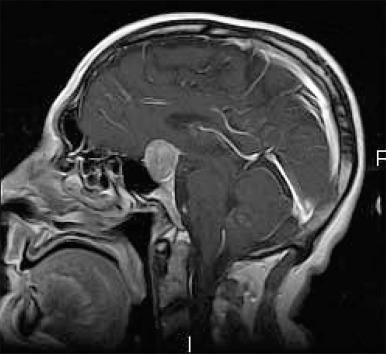
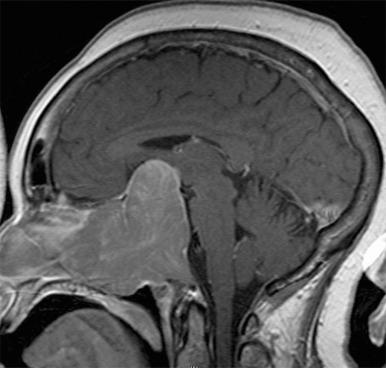
As noted by Saeger et al. “hormonally active adenomas are usually diagnosed at an earlier stage than hormonally inactive tumors, the latter being diagnosed mostly due to the effect of local pressure exerted by the already existing large tumor.” In the large German registry, 95%–100% of hormonally inactive tumors were macroadenomas. Nearly 100% of gonadotroph, null cell, sparsely granulated GH adenomas, clinically silent ACTH adenomas, TSH adenomas, acidophil stem cell adenomas, and plurihormonal PIT1-positive adenoma are macroadenomas. These are all relatively clinically nonfunctioning (gonadotroph) or aggressive (sparsely granulated GH adenoma, silent ACTH adenoma, acidophil stem cell adenoma, and plurihormonal PIT1-positive adenoma). However, more indolent functioning tumors, such as densely granulated GH adenomas, also present as macroadenomas in more than half of instances, as do prolactinomas in males. Table 44.4 lists which tumor subtypes are usually microadenomas versus macroadenomas.
| MICROADENOMAS | 85% PRESENT AS MACROADENOMAS | NEARLY 100% PRESENT AS MACROADENOMAS |
|---|---|---|
| Prolactinomas in females | Densely granulated GH cell adenomas | FSH/LH adenomas |
| ACTH-secreting adenomas (80% microadenoma) | Sparsely granulated GH cell adenomas | TSH adenomas |
| Plurihormonal adenomas | Acidophil stem cell adenomas | |
| Mixed GH/PRL tumors | Null cell adenomas | |
| Prolactinomas in males | Silent type 3 adenomas * |
* Currently referred to as “plurihormonal PIT1-positive adenoma.”
As previously described, some specific subtypes are more likely to present as microadenomas. Corticotroph adenomas producing Cushing syndrome present as microadenomas in 80% of cases. Also usually presenting as microadenomas are prolactinomas in premenopausal females. As noted by Saeger et al. microprolactinomas, even in patients who refuse therapy, have a low tendency to develop into macroadenomas and therefore may represent a distinct subset of prolactinomas.
Although the protocol for reporting primary pituitary tumors does not require a special designation of giant adenoma, this term has been utilized for adenomas with a maximum size of greater than 4 cm (see Fig. 44.15 ). Macroadenomas, and especially giant adenomas, often show cysts and hemosiderin pigment either by neuroimaging or in the tumor specimen. Many giant adenomas are gonadotroph adenomas or prolactinomas in males. Clinically silent corticotroph adenomas may also grow to this large size, as well as rarer clinically silent GH, TSH, and PRL+ adenomas. Despite giant size, clinically silent corticotroph adenomas usually manifest a low MIB-1 index, whereas other subtypes producing giant adenomas may show elevated MIB-1 rates. Thus, MIB-1 rates can be different in different subtypes of equal size, and proliferation rate does not parallel adenoma size in either macroadenoma or giant adenoma.
Become a Clinical Tree membership for Full access and enjoy Unlimited articles
If you are a member. Log in here